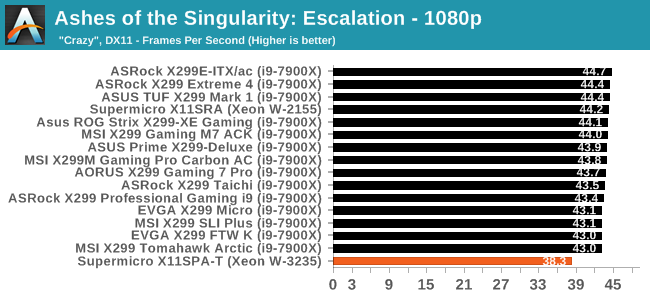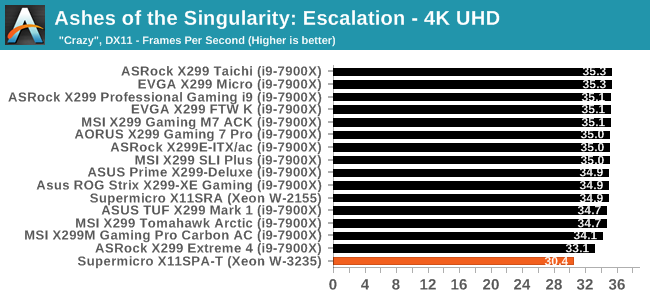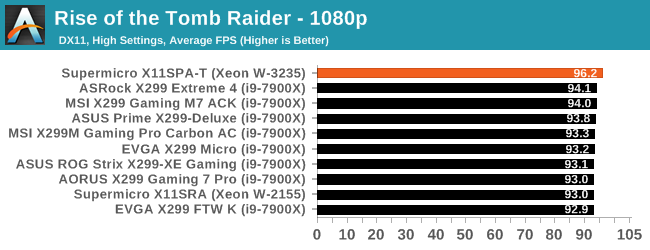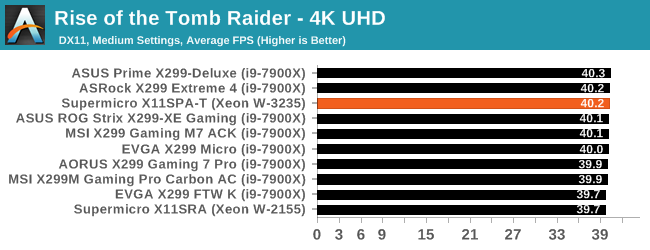The Supermicro X11SPA-T Review: An Impressive Cascade Lake Workstation Motherboard
by Gavin Bonshor on January 24, 2020 9:00 AM ESTGaming Performance
AoTS Escalation
Ashes of the Singularity is a Real-Time Strategy game developed by Oxide Games and Stardock Entertainment. The original AoTS was released back in March of 2016 while the standalone expansion pack, Escalation, was released in November of 2016 adding more structures, maps, and units. We use this specific benchmark as it relies on both a good GPU as well as on the CPU in order to get the most frames per second. This balance is able to better display any systematic differences in gaming as opposed to a more GPU heavy title where the CPU and system don't matter quite as much. We use the default "Crazy" in-game settings using the DX11 rendering path in both 1080p and 4K UHD resolutions. The benchmark is run four times and the results averaged then plugged into the graph.



Rise of the Tomb Raider
Rise of the Tomb Raider is a third-person action-adventure game that features similar gameplay found in 2013's Tomb Raider. Players control Lara Croft through various environments, battling enemies, and completing puzzle platforming sections, while using improvised weapons and gadgets in order to progress through the story.
One of the unique aspects of this benchmark is that it’s actually the average of 3 sub-benchmarks that fly through different environments, which keeps the benchmark from being too weighted towards a GPU’s performance characteristics under any one scene.













31 Comments
View All Comments
SSNSeawolf - Friday, January 24, 2020 - link
Gavin, can you comment as to why the W-3235 has a poor showing in some benchmarks, such as Ashes of the Singularity? It loses against it's older cousin, the 7900X, even though it has a slightly faster turbo, much more cache, more memory channels and the same mesh architecture.The only thing I can think of is that the 7900X is LCC Skylake silicon while the W-3235 is HCC, but it doesn't seem that such a big delta can be explained by an extra tile hop or two.
olafgarten - Friday, January 24, 2020 - link
As far as I know it's most likely because AOTS uses a lot of multiprocessing and so the HCC might make a difference therePCWarrior - Monday, January 27, 2020 - link
Three reasons for the difference:1. Looser memory timings (secondary, tertiary) on the workstation Supermicro boards compared to the enthusiast X299 ones with tighter timings. Also, likely looser primary timings (as well as looser secondary and tertiary) due to using 16GB DIMMs (and 6 of them) as opposed to 8GB DIMMS (and only 4 of them).
2. The cascade lake processors have built-in hardware mitigations that are known to have some performance impact. Sure this impact is smaller impact than equivalent software mitigations but larger impact than no security mitigations at all. The 7900X results show in the charts are likely from 2 years ago with no or fewer security mitigations applied.
3. Unlike enthusiast X299 boards that out-of-the box have no power limits and the cpu can turbo to its all-core turbo indefinitely, the Supermicro C246 boards adhere to Intel’s spec so the TDP is enforced after 28 (or so) seconds. So the 3235 in the above results was turboing to its all-core frequency (and we don’t know if it is 4GHZ as it is for the 7900X to begin with) for only 28 seconds - after that its frequency dropped to a value that would make the cpu power consumption not exceed 180W (i.e. equal to the TDP).
P.S: There is a mistake in the article. Specifically, under the Test Bed section it says that the board used was the X11SCA-W (instead of the X11SPA-T that this review is supposedly about). It also says that the RAM used was 2x16GB Corsair Vengeance LPX DDR4-2400 (run at 2666) which would have been the case for the X11SCA-W (mainstream 1151 socket and dual channel RAM). This board (the X11SPA-T) should have been tested with 6x16GB at 2933MHZ. Clearly the author forgot to fully update the table when he copy-pasted it from the older article about the X11SCA-W.
Tomatotech - Friday, January 24, 2020 - link
Nice to see how the big boys handle it. Most of my work is with mITX systems. Would be lovely to see a reasonably priced SFF mobo with more than 2 RAM slots and more than 1 nvme m.2 slot. There have been some but they’re not cheap.eastcoast_pete - Friday, January 24, 2020 - link
This board is outside my personal needs, but I would love to see a lower-priced good quality consumer ATX board with good VRMs, no LEDs and the appearance of this workstation board at a fair price. Something tells me I wouldn't be the only potential customer. Any takers?Foeketijn - Sunday, January 26, 2020 - link
I even emailed them to ask for a bullet proof no nonsense AM4 board (with official ECC support).otherwise - Tuesday, February 25, 2020 - link
The Asus "WS" boards are directly aimed at this market.watersb - Saturday, January 25, 2020 - link
Wow. Do I build one of these, or go for the Mac Pro?Licky McShmickletips - Saturday, January 25, 2020 - link
Please allow me to correct a small error in your postulation:"Do I build -two- of these, or buy one Mac Pro equivalent?"
Death666Angel - Saturday, January 25, 2020 - link
Do you need MacOS? Go with Apple. Do you just need a good workstation? Build it yourself. :)